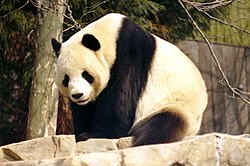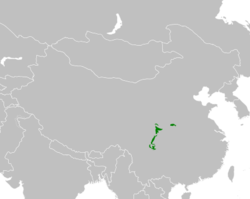
Back Panda Afrikaans ታላቅ ፓንዳ Amharic Ailuropoda melanoleuca AN Cattbera ANG باندا عملاقة Arabic پانضا عملاق ARY باندا عملاقه ARZ Ailuropoda melanoleuca AST КӀудияб панда AV Fierdol (Ailuropoda melanoleuca) AVK
| Giant panda | |
|---|---|

| |
| A giant panda at the Smithsonian National Zoological Park in Washington, D.C. | |
| Scientific classification | |
| Kingdom: | |
| Phylum: | |
| Class: | |
| Order: | |
| Family: | |
| Genus: | Ailuropoda
|
| Binomial name | |
| Ailuropoda melanoleuca (David, 1869)
| |

| |
| Giant panda range | |
The giant panda, Ailuropoda melanoleuca, is a bear.[1][2] It lives in south central China.[3]
Although it belongs to the order Carnivora, the panda's diet is almost 99% bamboo.[4] Pandas in the wild occasionally eat other grasses, wild tubers, or even meat in the form of birds, rodents or carrion. In captivity, they may get honey, eggs, fish, yams, shrub leaves, oranges, or bananas along with specially prepared food.[5][6]
The giant panda lives in a few mountain ranges in central China, mainly in Sichuan province, but also in the Shaanxi and Gansu provinces.[7] As a result of farming, deforestation and other development, the panda has been driven out of the lowland areas where it once lived.
- ↑ Scheff, Duncan (2002). Giant Pandas. Animals of the rain forest (illustrated ed.). Heinemann-Raintree Library. p. 7. ISBN 0-7398-5529-8.
- ↑ Lindburg, Donald G.; Baragona, Karen (2004). Giant Pandas: Biology and Conservation. University of California Press. ISBN 0-520-23867-2.
{{cite book}}: CS1 maint: multiple names: authors list (link) - ↑ Cite error: The named reference
iucnwas used but no text was provided for refs named (see the help page). - ↑ Quote: "Bamboo forms 99 percent of a panda's diet", "more than 99 percent of their diet is bamboo": p. 63 of Lumpkin & Seidensticker 2007 (as seen in the 2002 edition).
- ↑ "Giant Panda". Discovery Communications, LLC. Retrieved 8 August 2010.
- ↑ "Giant Pandas". National Zoological Park. Retrieved 7 November 2010.
- ↑ Scheff, Duncan (2002). Giant Pandas. Animals of the rain forest (illustrated ed.). Heinemann-Raintree Library. p. 8. ISBN 0-7398-5529-8.
